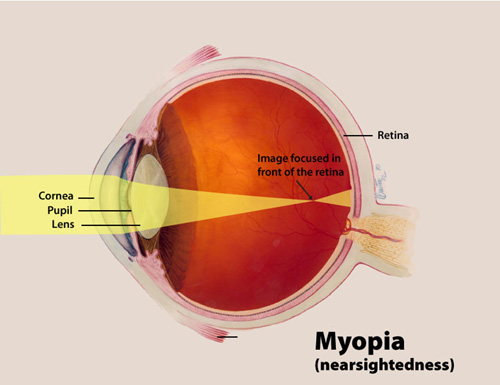What is myopia?
Myopia, also known as nearsightedness, is a common type of refractive error where close objects appear clearly, but distant objects appear blurry.

How does myopia develop?
Myopia develops in eyes that focus images in front of the retina instead of on the retina, which results in blurred vision. This occurs when the eyeball becomes too long and prevents incoming light from focusing directly on the retina. It may also be caused by an abnormal shape of the cornea or lens.
Who is at risk for myopia?
Myopia can affect both children and adults. The condition affects about 25 percent of Americans. Myopia is often diagnosed in children between 8 and 12 years of age and may worsen during the teen years. Little change may occur between ages 20 to 40, but sometimes myopia may worsen with age. People whose parents have myopia may be more likely to get the condition.
What are the signs and symptoms of myopia?
Some of the signs and symptoms of myopia include:
- Headaches
- Eyestrain
- Squinting
- Difficulty seeing distant objects, such as highway signs
How is myopia diagnosed?
An eye care professional can diagnose myopia and other refractive errors during a comprehensive dilated eye examination. People with this condition often visit their eye care professional with complaints of visual discomfort or blurred vision
How is myopia corrected?
Myopia can be corrected with eyeglasses, contact lenses, or surgery.
Eyeglasses are the simplest and safest way to correct myopia. Your eye care professional can prescribe lenses that will correct the problem and help you to see your best.
Contact Lenses work by becoming the first refractive surface for light rays entering the eye, causing a more precise refraction or focus. In many cases, contact lenses provide clearer vision, a wider field of vision, and greater comfort. They are a safe and effective option if fitted and used properly. However, contact lenses are not right for everyone. Discuss this with your eye care professional.
Refractive Surgery aims to permanently change the shape of the cornea which will improve refractive vision. Surgery can decrease or eliminate dependency on wearing eyeglasses and contact lenses. There are many types of refractive surgeries and surgical options should be discussed with an eye care professional.